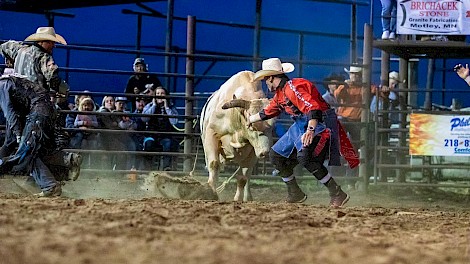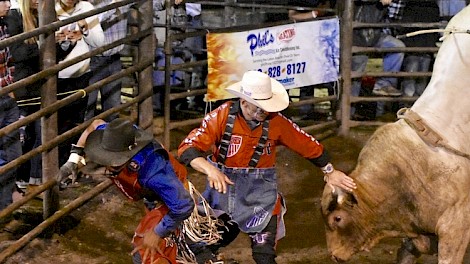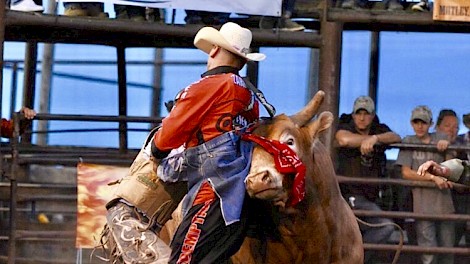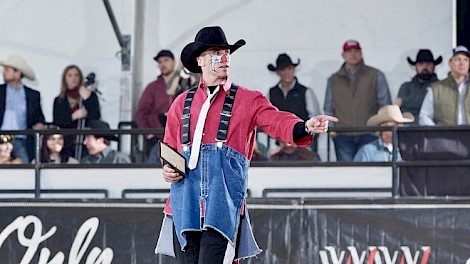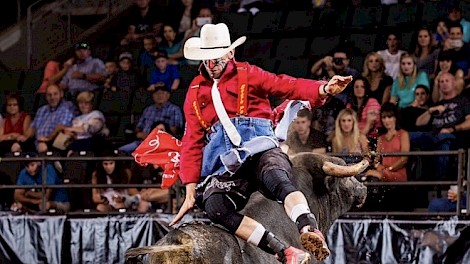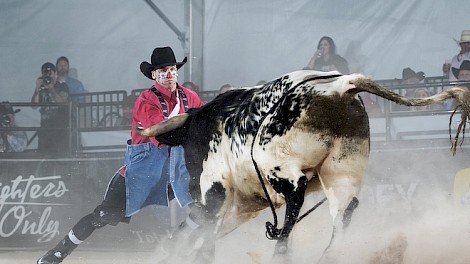Life In The Shoes of A Bullfighter
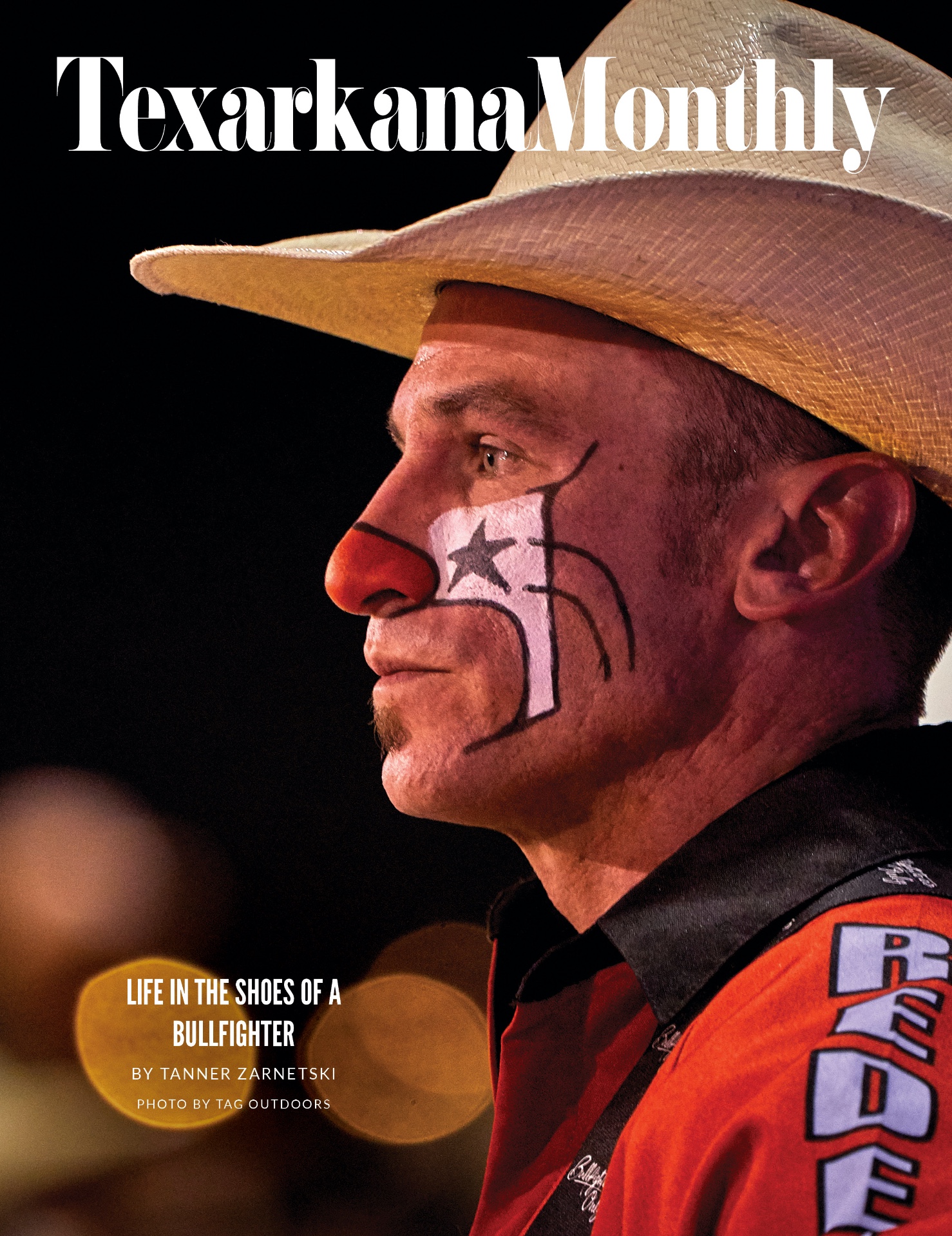
Have you ever been to a rodeo?
If your answer is no, I highly recommend you add it to your bucket list of things to do. If you have been to a rodeo, I’m sure you’ve noticed the brave, yet possibly crazy guys who strap themselves onto the back of a raging bull to attempt an 8 second ride.
Somewhere in the chaos and clouds of dust are the individuals in the arena, called bullfighters, who go nearly unnoticed. You may know them better by the old school term “rodeo clown.” Years ago, a rodeo clown performed acts to entertain the crowd and protect the bull riders from being run over or horned by the bull. These days, however, a rodeo clown only performs humorous acts and gestures to fill the downtime of the rodeo and to keep spectators interested. On the other hand, a bullfighter is there specifically to step into harm’s way and catch the attention of a raging bull and to distract him from running over the bull rider once he dismounts or gets thrown to the ground. There isn’t much that’s funny about that task.
Now that you are a little more educated about the tasks of a bullfighter, let me help you experience the thrill from my shoes. My name is Tanner Zarnetski and I am from the wonderful town of Texarkana, Texas. I am now 31 years old and still pursuing a career as a bullfighter. I have grown up around the rodeo my whole life and started fighting bulls regularly after I realized that I am a better bullfighter than I was a bull rider, which I did throughout the majority of my school-aged years.
As a bullfighter, I am considered contract personnel, which means I am paid to perform my tasks. A rodeo committee or stock contractor may contact me and offer a price for my work. Smaller organized rodeos cannot always afford to pay for more highly accomplished bullfighters to work. Therefore, they may hire one who is trying to climb up the ranks. I have been part of many rodeo organizations, but the most recognized organization I’ve been approved to work for is the Professional Rodeo Cowboys Association (PRCA) with whom I’ve earned my pro card. This is the same organization who puts together the National Finals Rodeo, typically held annually in Las Vegas, Nevada.
As a bullfighter, I must stay in good athletic shape. Although I’m not as strict with my diet as I should be, it can have a major effect on performance. Many bullfighters stay fit by staying active in a gym or regularly running and cycling.
On days I have a rodeo, I am usually on the rodeo premises two to three hours prior to the start of the event. In that time, I will paint my face. Like all bullfighters, I have a signature design. I use theatrical paint and top it with baby powder to dry it. I then step into my padded shorts, such as football style thigh and hip pads, to help soften the blow of hits taken throughout the night. I wear a football style cleat shoe to help maneuver in the loose and unleveled dirt. Then, it’s typical to see this crazy, denim-skirt looking attire held up by some suspenders, which are known as “baggies.” Not all bullfighters still wear baggies, but they are an old school tradition that I still love. Baggies also help to distract the bull just a little bit more.
One may imagine that I am crazy or wonder how an individual could enjoy such an act, all while laying my life on the line to save a bull rider. It is definitely an ability and passion that one is born with. It’s not that I’m fearless, because you can bet, I will not be skydiving in my lifetime. There’s just something about bull fighting!
In your mind, slip into my cleats and imagine this — you are standing at the edge of a bucking chute while a bull rider is getting strapped onto his bull. Your heart is thumping hard and fast because of the adrenaline. At any second, the bull rider will nod his head and they will open the gate. Things are moving so fast, yet it all feels like slow motion. At any moment, that bull rider will hit the ground and you know you must do all you can to get him to safety. There it is, I see his body position get out of hand, so I move to his aid. I must do whatever it takes to keep him from becoming harmed. Unfortunately, at times a bull rider can be pulled beneath the weight of the animal. At that point, all I can do is get the bull’s attention and encourage him to chase me away, hopefully allowing the bull rider time to get to safety.
It is a very dangerous job, and there are very few nights that a rodeo ends without a bull coming in contact with me. He leaves bruises, scrapes, muscle soreness, and even scars. I wear a protective vest which is a thin foam padding covered by a lightweight hard-shell plastic that covers my ribs, spine and sternum area, but all the precautions I can take still pale in comparison to the strength of the bull. I have broken many bones in my career as a bullfighter and punctured both lungs at separate times. Many injuries I have sustained and still had to perform my duties the rest of the night and through the weekend. That’s the job I have taken on and the commitment I have made.
So, next time you are at a rodeo, keep your eyes peeled for the bullfighters. Don’t miss the efforts he must put forth to keep the riders safe. It’s a dangerous, heart-pounding, body bruising, wonderful, exciting addiction to those of us lucky enough to be in the ring. ![]()

